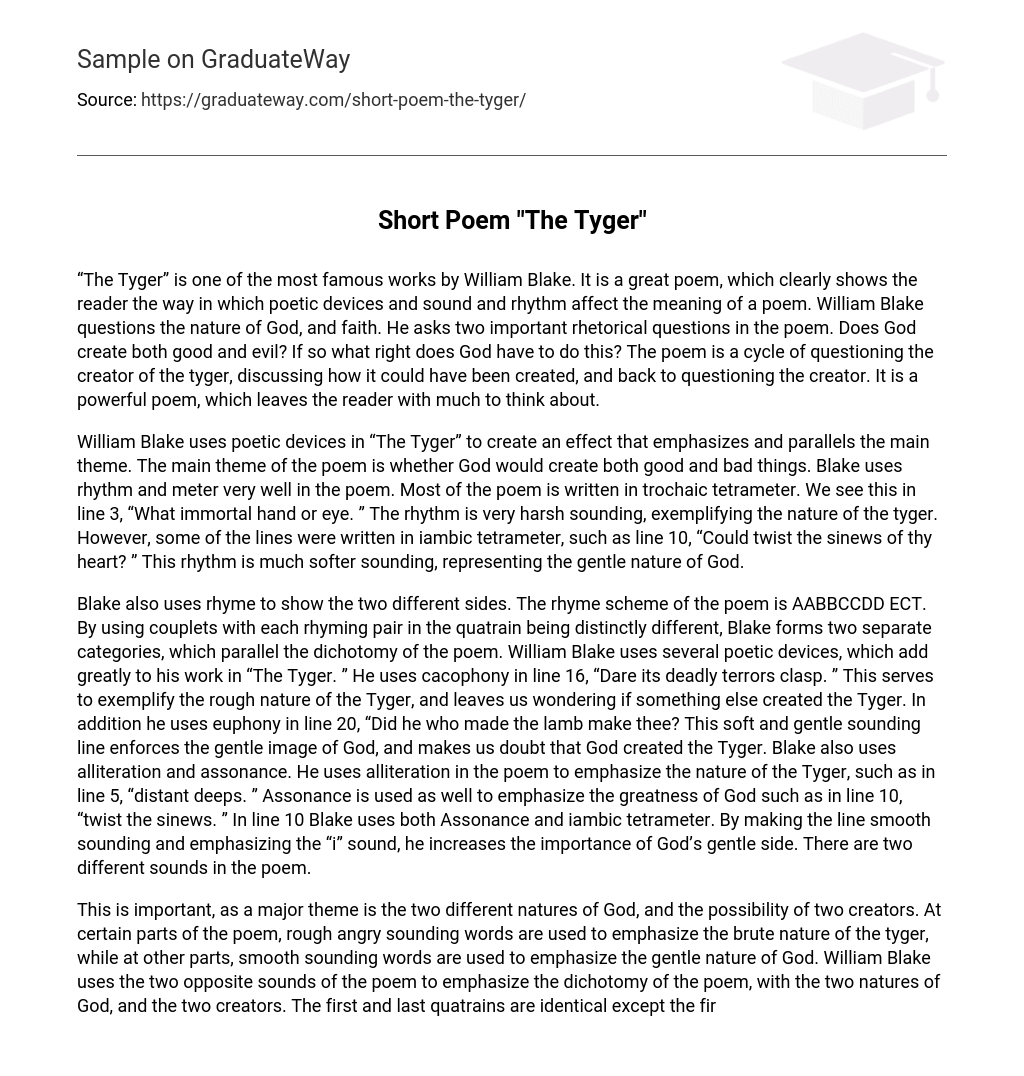“The Tyger” by William Blake is a renowned poem that adeptly showcases the impact of poetic devices, as well as sound and rhythm, on a poem’s meaning. Blake raises inquiries regarding the nature of God and faith through two significant rhetorical questions within the poem. One questions whether God is responsible for both goodness and evil, while the other wonders about the divine justification for such creation. The poem revolves around a cycle of pondering over the creator of the tyger, delving into its origins, and reverting back to questioning the creator. Ultimately, it is a profound poem that leaves much for readers to contemplate.
William Blake employs various poetic devices in his poem “The Tyger” to accentuate and mirror the central theme. The poem explores the question of whether God would be responsible for creating both good and evil. Blake skillfully utilizes rhythm and meter throughout the poem, predominantly employing trochaic tetrameter. This is evident in line 3, where he questions, “What immortal hand or eye.” The resulting harsh and jarring rhythm effectively captures the essence of the tyger. However, Blake also incorporates lines written in iambic tetrameter, such as line 10, which asks, “Could twist the sinews of thy heart?” This softer and gentler rhythm serves to symbolize the compassionate nature of God.
Blake employs various poetic devices in “The Tyger” to illustrate the contrasting sides. The rhyme scheme of the poem is AABBCCDD ECT, with each rhyming pair in the quatrain being distinct, thus dividing the poem into two categories that mirror its dichotomy. The utilization of cacophony in line 16, “Dare its deadly terrors clasp,” exemplifies the Tyger’s rough nature and raises questions about its creator. Moreover, euphony in line 20, “Did he who made the lamb make thee?” emphasizes the gentle image of God while casting doubt on His involvement in creating the Tyger. Additionally, Blake employs alliteration to accentuate the Tyger’s nature, as seen in line 5, “distant deeps.” Assonance is also utilized to underscore the greatness of God, as evidenced in line 10, “twist the sinews.” In this line, Blake employs both Assonance and iambic tetrameter to create a smooth and significant sound that highlights God’s gentle side. The poem contains two distinct sounds.
This passage highlights the importance of the theme of the two different natures of God and the possibility of two creators. In certain sections of the poem, harsh and aggressive words are employed to accentuate the savage qualities of the tyger, while in other parts, soft and smooth words are used to emphasize the gentle nature of God. William Blake harnesses these contrasting sounds in the poem to underscore its dichotomy, encompassing the two natures of God and the two creators. The first and last quatrains share similarities, except for slight modifications in the first words of the last lines of each quatrain.
The author questions the audacity of God in creating the Tyger, using the word “dare” instead of “could.” The poem “The Tyger” by William Blake explores the nature of God through a shift in rhythm and the use of couplets to underscore its contrasting elements. Blake employs various poetic devices to deepen the inquiry into God’s nature. Ultimately, he refrains from providing a definitive answer, leaving readers to contemplate if such an answer exists.





